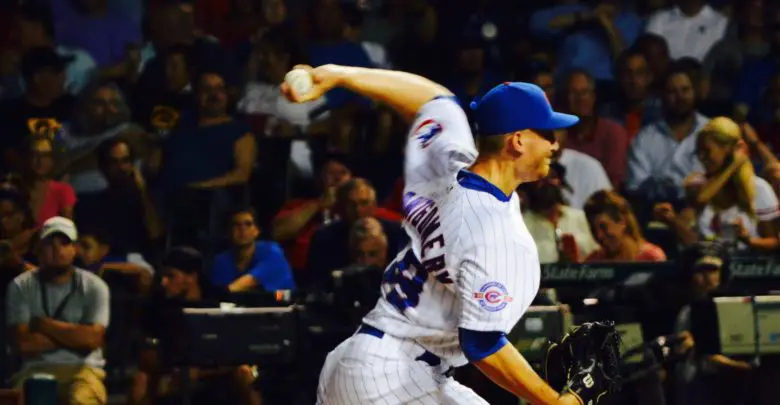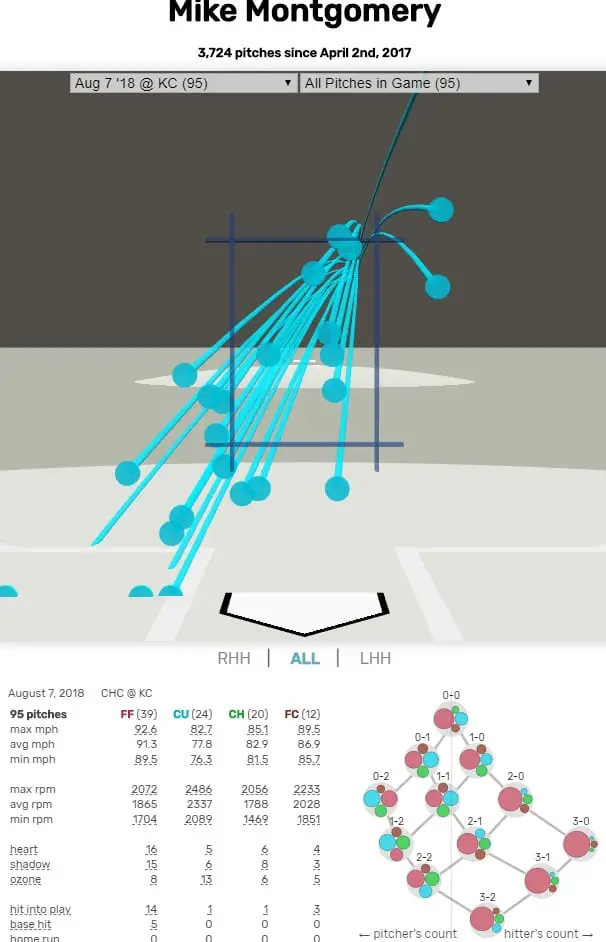
Mike Montgomery’s New Curveball Grip May Be Fueling Improved Results
Let me just start this out by reiterating that I’ve never really liked Mike Montgomery as a starter, at least not on a permanent basis. I suppose you could say it’s a hill I’m willing to die on, but mainly because it took too much effort for me to get up here and I’m too lazy to climb back down. And after seeing him struggle a bit through several starts, I figured I was safe staying put.
Some recent developments, however, have me at least considering a trek to a slightly lower altitude. Montgomery has allowed only two total earned runs over three of his last four starts, with the exception being that stinker in St. Louis near the end of July. He also went more than five innings in each of those three solid starts, the only games in which he’s gone that deep since June 24.
Seeing him back out there for the 7th inning Tuesday night was a surprise, particularly since he was already at 93 pitches. But he was on a very short leash and he was pulled just two pitches in after giving up a single to Adalberto Mondesi.
That’s not dissimilar from the way Joe Maddon quick-hooked him in his last start, allowing Montgomery to bat for himself in the 5th and then going to get him nine pitches into the 6th after a walk to Eric Hosmer. The litmus test seems to be letting a batter reach base, which while arbitrary, does at least provide some plausible grounds for removal.
The difference between that previous start and this most recent one was Monty’s pitch count, which only reached 79 against the Padres. It seemed at the time as though Maddon and the Cubs were being overly cautious and treating the swingman with kid gloves to keep from breaking him prior to October. But Tuesday’s 95-pitch outing would seem to refute that notion.
Some of the change in philosophy, if there was one at all, could be due to the positive progress of Yu Darvish and back-to-back solid outings by Cole Hamels. A change that is absolutely certain, though, is the one Montgomery made to his signature pitch.
“I changed the grip on my curveball,” Montgomery said Thursday night (you should read that whole linked piece from Tony Andracki of NBC Sports Chicago because it’s chock full of great stuff). “It played a lot better, so I’m gonna kinda work on that and continue to better that.”
I won’t blame you for being at least a little concerned about a mid-season grip change, particularly one that didn’t yield obvious results that first time out. After all, Montgomery only struck out one Padre and generated a grand total of one swinging strike all game. Those were actually one in the same and came on the cutter, another change the lefty has been working in.
He’s incorporating that offering more frequently for the express purpose of missing more bats, through the curve is admittedly his bread and butter. It’s that pitch that needs to work in order to keep hitters honest and to get that high percentage of grounders Montgomery has been known for.
“I recognized what [the curve] was doing,” Montgomery said last week. “It wasn’t breaking and generating what I wanted it to be. I’m slowly trying to make a change. When it gets better, you have the confidence to throw it in different counts. And for the way I pitch, having a good curveball makes a big difference.”
He admitted that it would probably take a while for the grip change to really take effect, though the results from Tuesday’s game in Kansas City may say otherwise. Not only was it the first time since June 29 that Montgomery had struck out more than three batters (he had four), but it was the first of his starts the Cubs had actually won since then.
To illustrate what he’s doing differently, let’s take a look at some 3D visualizations courtesy of Baseball Savant, a site that is absolutely bursting with all kinds of Statcast goodness. The first of these represents the aggregated locations of Montgomery’s various pitches, with the curve shown in blue (different locations for batter handedness). The next chart shows all of his pitches from Tuesday’s game and the third illustrates just his curveball from that win.
Take a look and meet me below for little breakdown party.



It doesn’t take a stats wizard — even someone with the slightest knowledge of baseball, for that matter — to see that the curveball is moving differently. Or at least that Montgomery was locating it differently Tuesday night. Whereas he had been more or less splitting the plate previously, he was really burying his bender down and in to righties.
He also used the pitch almost exclusively against right-handed hitters, who saw 23 of the 24 (95.8%) curves Monty threw. That’s a stark departure from his normal routine, since nearly 21 percent of Montgomery’s curves on the season have come against lefties. Then again, Alex Gordon was the only lefty the Royals employed in Tuesday’s starting lineup and he saw only six pitches in three at-bats against Montgomery.
So where am I going with all this? That’s an excellent question since there are really no definitive conclusions to be drawn from a single game against a clearly inferior opponent. But while it’s usually fruitless or even dangerous to make pronouncements based on such a small sample, information like that above can be quite useful as part of a breadcrumb trail of sorts.
Provided the woodland creatures don’t come along and eat our makeshift guideposts, we can use them to establish reference points that allow us to look back once additional data has been collected. If we see continued strong efforts from Montgomery over the remainder of the season, we can come back to this and see where things changed.
The real key will be keeping that curveball down and in, or just down in general, then being able to come with the cutter and changeup for a little more swing-and-miss. That latter offering generated more swinging strikes (six) than any other Tuesday and probably deserves more than just this throw-away blurb. Continued results like that will certainly earn more publicity in the future.
Following this general formula will serve Montgomery well whether he’s in the rotation or the bullpen, especially if he’s in the latter come higher leverage moments late in the season and/or the playoffs.
